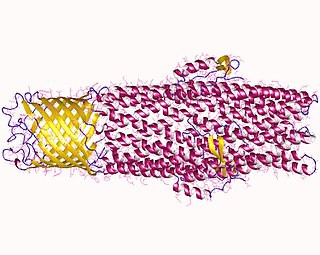
Streptomyces is the largest genus of Actinomycetota and the type genus of the family Streptomycetaceae. Over 500 species of Streptomyces bacteria have been described. As with the other Actinomycetota, streptomycetes are gram-positive, and have genomes with high GC content. Found predominantly in soil and decaying vegetation, most streptomycetes produce spores, and are noted for their distinct "earthy" odor that results from production of a volatile metabolite, geosmin.

Cephems are a sub-group of β-lactam antibiotics including cephalosporins and cephamycins. It is one of the most common 4-membered ring heterocycle. Produced by actinomycetes, cephamycins were found to display antibacterial activity against a wide range of bacteria, including those resistant to penicillin and cephalosporins. The antimicrobial properties of Cephem include the attachment to certain penicillin-binding proteins that are involved in the production of cell walls of bacteria.

Platensimycin, a metabolite of Streptomyces platensis, is an antibiotic, which act by blocking enzymes.

In microbiology, efflux is the moving of a variety of different compounds out of cells, such as antibiotics, heavy metals, organic pollutants, plant-produced compounds, quorum sensing signals, bacterial metabolites and neurotransmitters. All microorganisms, with a few exceptions, have highly conserved DNA sequences in their genome that encode efflux pumps. Efflux pumps actively move substances out of a microorganism, in a process known as active efflux, which is a vital part of xenobiotic metabolism. This active efflux mechanism is responsible for various types of resistance to bacterial pathogens within bacterial species - the most concerning being antibiotic resistance because microorganisms can have adapted efflux pumps to divert toxins out of the cytoplasm and into extracellular media.
TAN-1057 A and TAN-1057 B are organic compounds found in the Flexibacter sp. PK-74 bacterium. TAN-1057 A and B are closely related structurally as diastereomers. Also related are TAN-1057 C and TAN-1057 D, isolated from the same bacteria. The four compounds have been shown to be an effective antibiotics against methicillin-resistant strains of Staphylococcus aureus which act through the inhibition of protein biosynthesis.

Clavams are a class of antibiotics. This antibiotic is derived from Streptomyces clavuligerus NRRL 3585. Clavam is produced to form a new β-lactam antibiotic. This class is divided into the clavulanic acid class and the 5S clavams class. Clavulanic acid is a broad-spectrum antibiotic and 5S clavams may have anti-fungal properties. They are similar to penams, but with an oxygen substituted for the sulfur. Thus, they are also known as oxapenams.
Venturicidins are a group of antifungal compounds. The first member of this class was isolated from Streptomyces bacteria in 1961. Additional members of this class were subsequently isolated and characterized. An antifungal substance "aabomycin A" was isolated from Streptomyces in 1969. However, in 1990 it was reported that aabomycin A is actually a 3:1 mixture of two related components, which were then named aabomycin A1 and aabomycin A2. The structures of these were shown to be identical with those of the previously characterized compounds venturicidin A and venturicidin B, respectively. A new analog, venturicidin C, was recently reported from a Streptomyces isolated from thermal vents associated with the Ruth Mullins coal fire in Kentucky.
Caprazamycins are chemical compounds isolated from Streptomyces which have some antibiotic activity.

Bottromycin is a macrocyclic peptide with antibiotic activity. It was first discovered in 1957 as a natural product isolated from Streptomyces bottropensis. It has been shown to inhibit methicillin-resistant Staphylococcus aureus (MRSA) and vancomycin-resistant Enterococci (VRE) among other Gram-positive bacteria and mycoplasma. Bottromycin is structurally distinct from both vancomycin, a glycopeptide antibiotic, and methicillin, a beta-lactam antibiotic.
Naphthomycins are a group of closely related antimicrobial chemical compounds isolated from Streptomyces. They are considered a subclass of ansamycins.
Streptomyces isolates have yielded the majority of human, animal, and agricultural antibiotics, as well as a number of fundamental chemotherapy medicines. Streptomyces is the largest antibiotic-producing genus of Actinomycetota, producing chemotherapy, antibacterial, antifungal, antiparasitic drugs, and immunosuppressants. Streptomyces isolates are typically initiated with the aerial hyphal formation from the mycelium.

The cyclothiazomycins are a group of natural products, classified as thiopeptides, which are produced by various Streptomyces species of bacteria.

Streptomyces antibioticus is a gram-positive bacterium discovered in 1941 by Nobel-prize-winner Selman Waksman and H. Boyd Woodruff. Its name is derived from the Greek "strepto-" meaning "twisted", alluding to this genus' chain-like spore production, and "antibioticus", referring to this species' extensive antibiotic production. Upon its first characterization, it was noted that S. antibioticus produces a distinct soil odor.
Streptomyces hokutonensis is a bacterium species from the genus of Streptomyces which has been isolated from rhizosphere roots from strawberries in Hokuto, Yamanashi in Japan.
Streptomyces nitrosporeus is a bacterium species from the genus of Streptomyces which has been isolated from garden soil in Japan. Streptomyces nitrosporeus produces Benzastatin E, Benzastatin F, Benzastatin G Nitrosporeusine A and Nitrosporeusine B and the antibiotics nitrosporin and virantomycin and the inhibitor of angiotensin-converting enzyme foroxymithine. Streptomyces nitrosporeus can degrade cellulose.
Streptomyces platensis is a bacterium species from the genus of Streptomyces which has been isolated from soil. Streptomyces platensis produces oxytetracycline, platensimycin, migrastatin, isomigrastatin, platencin, dorrigocin A, dorrigocin B and terramycine.
Tsukamurella pulmonis is a Gram-positive and aerobic bacterium from the genus Tsukamurella which has been isolated from the sputum from a patient with lung tuberculosis in Germany.
Butyrolactol A is an organic chemical compound of interest for its potential use as an antifungal antibiotic.
Streptomyces abyssomicinicus is a bacterium species from the genus of Streptomyces which has been isolated from rock soil. Streptomyces abyssomicinicus produces abyssomicin.
Streptomyces lydicamycinicus is a bacterium species from the genus of Streptomyces. Streptomyces lydicamycinicus produces the antibiotic lydicamycin.








